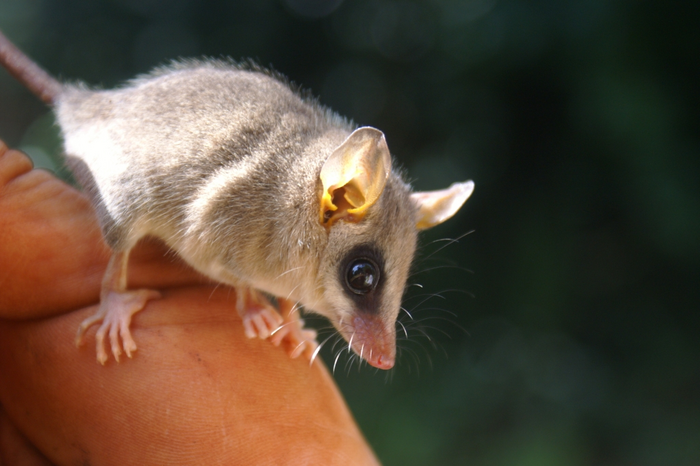CHICAGO — Rapid deforestation in eastern Paraguay is changing the region’s subtropical ecosystems, creating a fragmented landscape of forest remnants. Along the edges between the disappearing forests and new soy farms, species from both habitats collide in novel interactions. A study from DePaul University researcher Noé de la Sancha models new dimensions of biodiversity among small mammal populations, as a function of how far they dwell from the forest’s edge. The research is published in the journal Diversity and Distributions.

Credit: Noé de la Sancha
CHICAGO — Rapid deforestation in eastern Paraguay is changing the region’s subtropical ecosystems, creating a fragmented landscape of forest remnants. Along the edges between the disappearing forests and new soy farms, species from both habitats collide in novel interactions. A study from DePaul University researcher Noé de la Sancha models new dimensions of biodiversity among small mammal populations, as a function of how far they dwell from the forest’s edge. The research is published in the journal Diversity and Distributions.
The findings could be important for conservationists and epidemiologists following disease risks as humans, livestock and exotic animals interact along these border areas. “It’s more important than ever, as people are living closer to these forest patches, that we understand what is happening to small mammal populations,” said de la Sancha, an assistant professor of environmental science and studies.
The study includes models that compare several diversity metrics for small mammals, all related to distance to the edge of the forest (DTE). The team charted phylogenetics (comparing how closely species are related); functions (what an animal does, such as eating); richness (the number of different species found in one area); and abundance (the prevalence of a single species).
“Edge-effects have been widely studied, but not as much is known about small mammal populations in eastern Paraguay. We are still discovering why ecological changes favor some species over others, particularly related to functional and phylogenetic differences,” said de la Sancha.
Researchers sampled a gradient from the interior of mature forest remnants towards their edges. They established replicated trapping grids and used high-resolution satellite imagery to measure the distance of each trap from the edge of the forest. Studying small, non-flying mammals has its advantages, explained de la Sancha. They are easier to trap and trace, measure and gather. They have short lifespans, high levels of diversity and importance within an ecosystem.
As expected, researchers found both richness and abundance (the prevalence of a single species) increased closer to forest edges. “It turns out we don’t see a lot of richness or abundance of small mammals in the interior of really large forest preserves. But when you get to the edges, they explode in numbers,” said de la Sancha, who is also a research associate at the Field Museum of Natural History in Chicago.
The team also measured the species’ phylogenetic diversity, which shows how closely related the species are to each other. Sites toward the forest’s interior tended to have more closely related species, and edges tended to be represented by more phylogenetically distinct species. The functionality of these phylogenetically diverse species along the edges surprised researchers.
“One might expect that as more novel species are coming into the forest remnants, they would bring new ecological functions to perform, but that doesn’t seem to be the case overall,” said de la Sancha. “Invading species are just replacing other functionally similar forest species.” Among exotic and invasive species, researchers found Rattus rattus, or the common European black rat, entering forests along the edge.
The rise of generalists is another theme of the study: They were found to thrive along edges and within forest remnants. “Generalists can live across many environments, and researchers found several types were especially abundant along forest edges. Generalists are taking over the world, but generalists are not all the same,” de la Sancha says.
For example, researchers charted the presence of forest generalists including Akodon montensis, grassland generalists including Calomys callosus and the cosmopolitan Rattus rattus, an invasive species that can be found all over the world. Each has their own habitat, diet and behaviors.
In addition, de la Sancha and the team found previously established social and conservation metrics were not significant. “There’s a philosophy that if you protect jaguars, you protect everything underneath it in the ecosystem. However, the presence of jaguars, as well as other large animals like tapirs, did not seem to be an important indicator for edge effects on small mammals,” de la Sancha said. Similarly, researchers found neither an area’s conservation status, nor the presence of indigenous populations in or around the forest preserve seemed to have an effect on small mammal populations.
The team’s ongoing work in the shrinking Atlantic Forest of South America seeks to disentangle the mechanisms governing diversity along forest edges. As forests shrink, more species may come into closer contact with humans and livestock. In ongoing research in the area, de la Sancha is also measuring levels of stress among small mammals, with an eye toward assessing the risk of zoonotic disease, or those that can transfer from animals to humans.
Co-authors on the study are José F. González-Maya, Universidad Autónoma Metropolitana Unidad Lerma; Sarah A. Boyle of Rhodes College; Pastor E. Pérez-Estigarribia of Universidad Nacional de Asunción; J. Nicolas Urbina-Cardona of Pontificia Universidad Javeriana; and Nancy E. McIntyre of Texas Tech University.
###
Journal
Diversity and Distributions
DOI
10.1111/ddi.13663
Method of Research
Data/statistical analysis
Subject of Research
Animals
Article Title
Bioindicators of edge effects within Atlantic Forest remnants: Conservation implications in a threatened biodiversity hotspot
Article Publication Date
12-Jan-2023
COI Statement
The authors declare no conflicts of interest.




